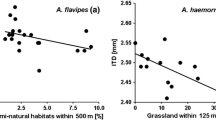Summary
The composition and dynamics of foraging assemblages of bees were examined from the standpoint of species-level arrival and departure processes in patches of flowers. Experiments with bees visiting 4 different species of flowers in subalpine meadows in Colorado gave the following results:
-
1)
In enriched patches the rates of departure of bees were reduced, resulting in increases in both the number of bees per species and the average number of species present.
-
2)
The reduction in bee departure rates from enriched patches was due to mechanical factors-increased flower handling time, and to behavioral factors-an increase in the number of flowers visited per inflorescence and in the number of inflorescences visited per patch. Bees foraging in enriched patches could collect nectar 30–45% faster than those foraging in control patches.
-
3)
The quantitative changes in foraging assemblages due to enrichment, in terms of means and variances of species population sizes, fraction of time a species was present in a patch, and in mean and variance of the number of species present, were in reasonable agreement with predictions drawn from queuing theory and studies in island biogeography.
-
4)
Experiments performed with 2 species of flowers with different corolla tube lengths demonstrated that manipulation of resources of differing availability had unequal effects on particular subsets of the larger foraging community.
The arrival-departure process of bees on flowers and the immigration-extinction process of species on islands are contrasted, and the value of the stochastic, species-level approach to community composition is briefly discussed.
Similar content being viewed by others
References
Abbott I (1983) The meaning of z in species/area regressions and the study of turnover in island biogeography. Oikos 41:385–390
Abele LG, Patton WK (1976) The size of coral heads and the community biology of associated decapod crustaceans. J Biogeogr 3:35–47
Anderson LS (1984) Organization of a plant-pollinator community in a seasonal habitat. PhD thesis, Univ of Arizona, Tucson
Brown JH, Kodric-Brown A (1977) Turnover rates in insular biogeography: effect of immigration on extinction. Ecology 58:445–449
Cairns J, Dahlberg ML, Dickson KL, Smith N, Waller WT (1969) The relationship of fresh-water protozoan communities to the MacArthur-Wilson equilibrium model. Am Nat 103:439–454
Charnov EL (1976) Optimal foraging, the marginal value theorem. Theor Pop Biol 9:126–136
Cohen JE (1971) Casual groups of monkeys and men: stochastic models of elemental social systems. Harvard Univ Press. Cambridge
Connor EF, Simberloff D (1979) The assembly of species communities: chance or competition? Ecology 60:1132–1140
Diamond JM, Gilpin ME (1983) Biogeographic umbilici and the origin of the Philippine avifauna. Oikos 41:307–321
Diamond JM, Marshall AG (1977) Distributional ecology of New Hebridean birds: a species kaleidoscope. J Anim Ecol 46:703–727
Gilpin ME, Diamond JM (1981) Immigration and extinction probabilities for individual species: relation to incidence functions and species colonization curves. Proc Nat Acad Sci USA 78:392–396
Graves GR, Gotelli NJ (1983) Neotropical land-bridge avifaunas: new approaches to null hypotheses in biogeography. Oikos 41:322–333
Gross D, Harris CM (1974) Fundamentals of queueing theory. Wiley, New York
Haila Y (1983) Land birds on northern islands: a sampling metaphor for insular colonization. Oikos 41:334–351
Heinrich B (1979) Resource heterogeneity and patterns of movement in foraging bumblebees. Oecologia 40:235–245
Hodges CM, Wolf LL (1981) Optimal foraging in bumblebees: why is nectar left behind in flowers? Behav Ecol Sociobiol 9:41–44
Inouye DW (1978) Resource partitioning in bumblebees: experimental studies of foraging behavior. Ecology 59:672–678
Janzen DH (1968) Host plants as islands in evolutionary and contemporary time. Am Nat 102:592–595
Janzen DH (1973) Host plants as islands. II. Competition in evolutionary and contemporary time. Am Nat 107:786–790
Jones HL, Diamond JM (1976) Short-time-base studies of turnover in breeding bird populations on the California Channel Islands. Condor 78:526–549
Macior LW (1974) Pollination ecology of the front Range of the Colorado Rocky Mountains. Melanderia 15:1–59
Noether GE (1967) Elements of nonparametric statistics. Wiley, New York
Pyke GH (1978) Optimal foraging: movement patterns of bumblebees between inflorescences. Theor Pop Biol 13:72–98
Pyke GH (1982) Foraging in bumblebees: rule of departure from an inflorescence. Can J Zool 60:417–428
Simberloff DS (1969) Experimental zoogeography of islands: a model for insular colonization. Ecology 50:296–314
Southwood TRE, Kennedy CEJ (1983) Trees as islands. Oikos 41:359–371
Strong DR (1974) Nonasymptotic species richness models and the insects of British trees. Proc Nat Acad Sci USA 71:2766–2769
Terborgh J, Winter B (1978) Some causes of extinction. In: Soule M, Wilcox BA (eds) Conservation biology: an evolutionary-ecological perspective. Sinauer, Sunderland, MA, p 119–134
Toft CA, Schoener TW (1983) Abundance and diversity of orb spiders on 106 Bahamian islands: biogeography at an intermediate trophic level. Oikos 41:411–426
Van Elteren Ph (1960) On the combination of independent two sample tests of Wilcoxon. Bull Inst Intern Stat 37:351–361
Whitham TG (1977) Coevolution of foraging in Bombus and nectar dispensing in Chilopsis: a last dreg theory. Science 197:593–596
Wright DH (1983) Species-energy theory: an extension of speciesarea theory. Oikos 41:496–506
Wright DH (1984) Available energy and species diversity: theory and experiments with bees. PhD thesis, Univ of Arizona, Tucson
Zimmerman M (1983) Calculating nectar production rates: residual nectar and optimal foraging. Oecologia (Berlin) 58:258–259
Author information
Authors and Affiliations
Rights and permissions
About this article
Cite this article
Wright, D.H. Patch dynamics of a foraging assemblage of bees. Oecologia 65, 558–565 (1985). https://doi.org/10.1007/BF00379673
Received:
Issue Date:
DOI: https://doi.org/10.1007/BF00379673




